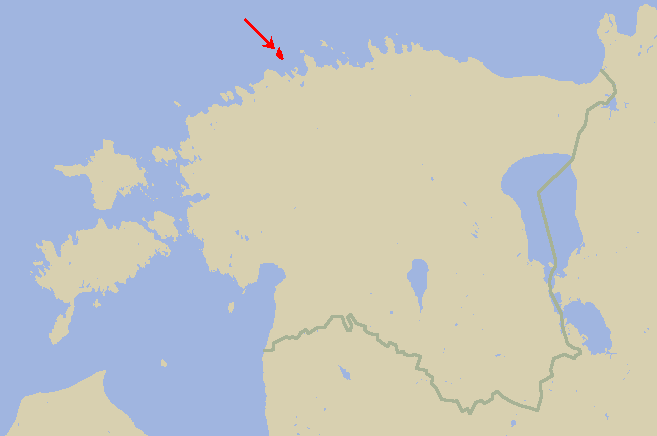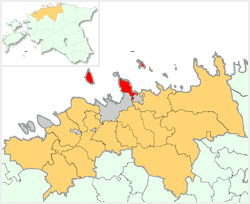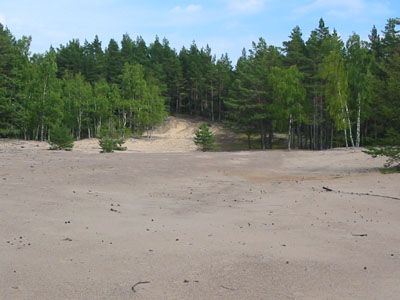Naissaar on:
[Wikipedia]
[Google]
[Amazon]


 Naissaar ( sv, Nargö; german: Nargen) is an island in
Naissaar ( sv, Nargö; german: Nargen) is an island in  Until World War II, the island's native population numbered about 450 people of Estonian-Swedish origin. However, all of the local residents fled from Naissaar to escape the 1944 Soviet invasion of Estonia. During the 1944–1991
Until World War II, the island's native population numbered about 450 people of Estonian-Swedish origin. However, all of the local residents fled from Naissaar to escape the 1944 Soviet invasion of Estonia. During the 1944–1991
 During the 1944–1991 Soviet occupation, the largest factory for
During the 1944–1991 Soviet occupation, the largest factory for
Naissaare põhjatipp.jpg, Naissaare lighthouse
Naissaare sadama tulepaak 2016 - 02.jpg, Naissaare harbour light beacon
Omari küün Naissaarel (1).jpg, Omari barn
Mälestusmärk Naissaare kalmistul.jpg, Memorial stone in cemetery
Paadisadam Naissaarel.jpg, South coast of Naissaar
Naissaare Church, 2016.jpg, Naissaare Church
"Jalutuskäik saladusliku Naissaare lõunarajal"Fortress of Naissaar
{{Coord, 59, 34, N, 24, 31, E, region:EE_type:isle, display=title Estonian islands in the Baltic States and territories established in 1917 Kreis Harrien Viimsi Parish Tourist attractions in Harju County Former socialist republics


 Naissaar ( sv, Nargö; german: Nargen) is an island in
Naissaar ( sv, Nargö; german: Nargen) is an island in Estonia
Estonia, formally the Republic of Estonia, is a country by the Baltic Sea in Northern Europe. It is bordered to the north by the Gulf of Finland across from Finland, to the west by the sea across from Sweden, to the south by Latvia, an ...
. It is situated in the Gulf of Finland
The Gulf of Finland ( fi, Suomenlahti; et, Soome laht; rus, Фи́нский зали́в, r=Finskiy zaliv, p=ˈfʲinskʲɪj zɐˈlʲif; sv, Finska viken) is the easternmost arm of the Baltic Sea. It extends between Finland to the north and ...
, northwest of the capital city Tallinn
Tallinn () is the most populous and capital city of Estonia. Situated on a bay in north Estonia, on the shore of the Gulf of Finland of the Baltic Sea, Tallinn has a population of 437,811 (as of 2022) and administratively lies in the Harju '' ...
, and is administratively part of the Viimsi parish. The island covers an area of . It is long and wide, and lies about from the mainland. The highest point on the island is Kunilamägi, which is above sea level
Height above mean sea level is a measure of the vertical distance ( height, elevation or altitude) of a location in reference to a historic mean sea level taken as a vertical datum. In geodesy, it is formalized as '' orthometric heights''.
Th ...
. The island consists predominantly of coniferous forest and piles of stones and boulders. In 2020, the island had a population of 17; in 2011 the island had 35 or so permanent residents and some summer residents. Administratively the island is divided into three villages: Lõunaküla
Lõunaküla ( sv, Storbyn) is a village in Viimsi Parish, Harju County in Estonia
Estonia, formally the Republic of Estonia, is a country by the Baltic Sea in Northern Europe. It is bordered to the north by the Gulf of Finland across ...
(Storbyn), Tagaküla (Bakbyn), and Väikeheinamaa (Lillängin).
 Until World War II, the island's native population numbered about 450 people of Estonian-Swedish origin. However, all of the local residents fled from Naissaar to escape the 1944 Soviet invasion of Estonia. During the 1944–1991
Until World War II, the island's native population numbered about 450 people of Estonian-Swedish origin. However, all of the local residents fled from Naissaar to escape the 1944 Soviet invasion of Estonia. During the 1944–1991 Soviet
The Soviet Union,. officially the Union of Soviet Socialist Republics. (USSR),. was a List of former transcontinental countries#Since 1700, transcontinental country that spanned much of Eurasia from 1922 to 1991. A flagship communist state, ...
occupation the island was used by the military and off-limits to the public.
Today, the previous small houses of the Swedish villages are being slowly restored, along with a narrow gauge railway that used to run from the north to the southern tip of the island.
A notable native of the island was Bernhard Schmidt, the German-Estonian optician who invented the Schmidt telescope in 1930.
Lighthouse
Naissaar Lighthouse was first built in 1788, though the present lighthouse dates to 1960. It is 47 meters tall.History
In theEstonian language
Estonian ( ) is a Finnic language, written in the Latin script. It is the official language of Estonia and one of the official languages of the European Union, spoken natively by about 1.1 million people; 922,000 people in Estonia and 160, ...
the name of the island, ''Nais-saar'', means "island of women", and it is possible that Naissaar is the island the chronicle of Adam of Bremen
Adam of Bremen ( la, Adamus Bremensis; german: Adam von Bremen) (before 1050 – 12 October 1081/1085) was a German medieval chronicler. He lived and worked in the second half of the eleventh century. Adam is most famous for his chronicle ''Gest ...
mentioned around 1075 under the name '' Terra Feminarum''. Estonian Swedish fishermen were well-established on the island by the 15th Century, and the Swedes erected a small fortress there in 1705 during the Great Northern War
The Great Northern War (1700–1721) was a conflict in which a coalition led by the Tsardom of Russia successfully contested the supremacy of the Swedish Empire in Northern, Central and Eastern Europe. The initial leaders of the anti-Swe ...
. After the war Estonia became part of the Russian Empire. A new fortress, with five bastions, was built in 1720, for the defense of Tallinn and St. Petersburg.
An epic single-ship action
A single-ship action is a naval engagement fought between two warships of opposing sides, excluding submarine engagements; called so because there is a single ship on each side. The following is a list of notable single-ship actions.
Single-shi ...
took place off the north end of the island on 1808 when the 14-gun Russian cutter ''Opyt'' put up an heroic though ultimately unsuccessful fight against the British 44-gun frigate
A frigate () is a type of warship. In different eras, the roles and capabilities of ships classified as frigates have varied somewhat.
The name frigate in the 17th to early 18th centuries was given to any full-rigged ship built for speed an ...
.
In 1850 the island's population was 155 people, and by 1858 it had grown to 188, most of whom were Estonian Swedes. Between 1853 and 1856 the inhabitants built a new chapel that was part of the Swedish parish of St. Michael in Tallinn.
The outbreak of World War I stopped most of the planned improvements for the military fortifications of Naissaar. Still, in 1914 the Russian Empire opened a narrow-gauge railway line on the island, with a total trackage of 37.7 km.
During the 1917 February Revolution
The February Revolution ( rus, Февра́льская револю́ция, r=Fevral'skaya revolyutsiya, p=fʲɪvˈralʲskəjə rʲɪvɐˈlʲutsɨjə), known in Soviet historiography as the February Bourgeois Democratic Revolution and some ...
, Russian battleship ''Petropavlovsk'' was based on Naissaar, which had been emptied of its inhabitants in 1914. A new fort was built on the island during World War I, stationing 80-90 Russian sailors. After the Bolsheviks
The Bolsheviks (russian: Большевики́, from большинство́ ''bol'shinstvó'', 'majority'),; derived from ''bol'shinstvó'' (большинство́), "majority", literally meaning "one of the majority". also known in English ...
seized power in Petrograd
Saint Petersburg ( rus, links=no, Санкт-Петербург, a=Ru-Sankt Peterburg Leningrad Petrograd Piter.ogg, r=Sankt-Peterburg, p=ˈsankt pʲɪtʲɪrˈburk), formerly known as Petrograd (1914–1924) and later Leningrad (1924–1991), i ...
and Tallinn
Tallinn () is the most populous and capital city of Estonia. Situated on a bay in north Estonia, on the shore of the Gulf of Finland of the Baltic Sea, Tallinn has a population of 437,811 (as of 2022) and administratively lies in the Harju '' ...
in November 1917, a local "Soviet (council) of Workers and Soldiers' Ambassadors" convened on Naissaar. The council formed a "People's Commissars' Council", which then declared itself "the government" of Naissaar on 17 December 1917. This government included the Commissioners ("ministers") for War, Home Affairs, Labor, Finance, Health, and, later, an Education Commissioner as well. Stepan Petrichenko, an anarcho-syndicalist sailor of ''Petropavlovsk'', was elected Chairman of the Council. The Council declared: "In constitutional terms, Naissaar has been designed to be an independent Soviet republic", naming it the Soviet Republic of Soldiers and Fortress-Builders of Naissaar.: "nõukogu kuulutab saare soldatite ja kindluseehitajate sotsialistlikuks vabariigiks." The government of the "Soviet republic of Naissaar" was, while not formally recognized as independent, actively supported by the Bolshevik government Under the leadership of Russian communist Vladimir Lenin, the Bolshevik Party seized power in the Russian Republic during a coup known as the October Revolution. Overthrowing the pre-existing Provisional Government, the Bolsheviks established a new ...
in mainland Estonia, who sent prisoners to the island "to fortify some of the castles, clear the railroads, carry snow and dig sand." However, after German
German(s) may refer to:
* Germany (of or related to)
**Germania (historical use)
* Germans, citizens of Germany, people of German ancestry, or native speakers of the German language
** For citizens of Germany, see also German nationality law
**Ge ...
forces occupied the island on 26 February 1918, the Russian Baltic fleet evacuated itself as well as the island's "government", moving towards Helsinki
Helsinki ( or ; ; sv, Helsingfors, ) is the Capital city, capital, primate city, primate, and List of cities and towns in Finland, most populous city of Finland. Located on the shore of the Gulf of Finland, it is the seat of the region of U ...
and then to Kronstadt. Thus the "soviet republic" ceased to exist.
In 1918–1940, the independent Republic of Estonia too used Naissaar as a naval base. In 1934, 450 people lived on the island, of whom 291 were Estonians, most of whom in turn were in the Estonian army. The army of the Republic of Estonia continued to use the railway for military purposes throughout the 1930s.
Although the fortifications on the island date back to Peter the Great
Peter I ( – ), most commonly known as Peter the Great,) or Pyotr Alekséyevich ( rus, Пётр Алексе́евич, p=ˈpʲɵtr ɐlʲɪˈksʲejɪvʲɪtɕ, , group=pron was a Russian monarch who ruled the Tsardom of Russia from t ...
's scheme to fortify Reval (Tallinn
Tallinn () is the most populous and capital city of Estonia. Situated on a bay in north Estonia, on the shore of the Gulf of Finland of the Baltic Sea, Tallinn has a population of 437,811 (as of 2022) and administratively lies in the Harju '' ...
), the main fortifications on Naissaar now are from the period that followed the Stalinist Soviet invasion and occupation of Estonia during World War II in 1940. The Soviet occupation of Naissaar was ended by the invading Nazi German Wehrmacht
The ''Wehrmacht'' (, ) were the unified armed forces of Nazi Germany from 1935 to 1945. It consisted of the ''Heer'' (army), the '' Kriegsmarine'' (navy) and the ''Luftwaffe'' (air force). The designation "''Wehrmacht''" replaced the previo ...
in August 1941. When the Red Army
The Workers' and Peasants' Red Army (Russian language, Russian: Рабо́че-крестья́нская Кра́сная армия),) often shortened to the Red Army, was the army and air force of the Russian Soviet Federative Socialist R ...
reinvaded Estonia in 1944, all of the remaining local Estonian-Swedish population escaped from the new Soviet occupation and took refuge in Sweden.
 During the 1944–1991 Soviet occupation, the largest factory for
During the 1944–1991 Soviet occupation, the largest factory for naval mine
A naval mine is a self-contained explosive device placed in water to damage or destroy surface ships or submarines. Unlike depth charges, mines are deposited and left to wait until they are triggered by the approach of, or contact with, an ...
s in the Baltics operated on Naissaar. The Soviet authorities declared the island a military area and off-limits to the public. The Soviets also used the railway to connect the factory to the port.
After Estonia had regained independence in 1991, the last Russian troops left Naissaar in early 1993. They burned the explosives in the naval mines, leaving a multitude of metal casings scattered throughout the island. Many of these were scavenged as scrap iron, but a field of mines is still visible near the wharf at Mädasadam. Another legacy of the former Soviet arms industry is that the soil of the island remains contaminated by oil and heavy metals.
In 1995 Naissaar Landscape Conservation Area was established, covering the entire area of the island.
Gallery
Citations
External links
"Jalutuskäik saladusliku Naissaare lõunarajal"
{{Coord, 59, 34, N, 24, 31, E, region:EE_type:isle, display=title Estonian islands in the Baltic States and territories established in 1917 Kreis Harrien Viimsi Parish Tourist attractions in Harju County Former socialist republics